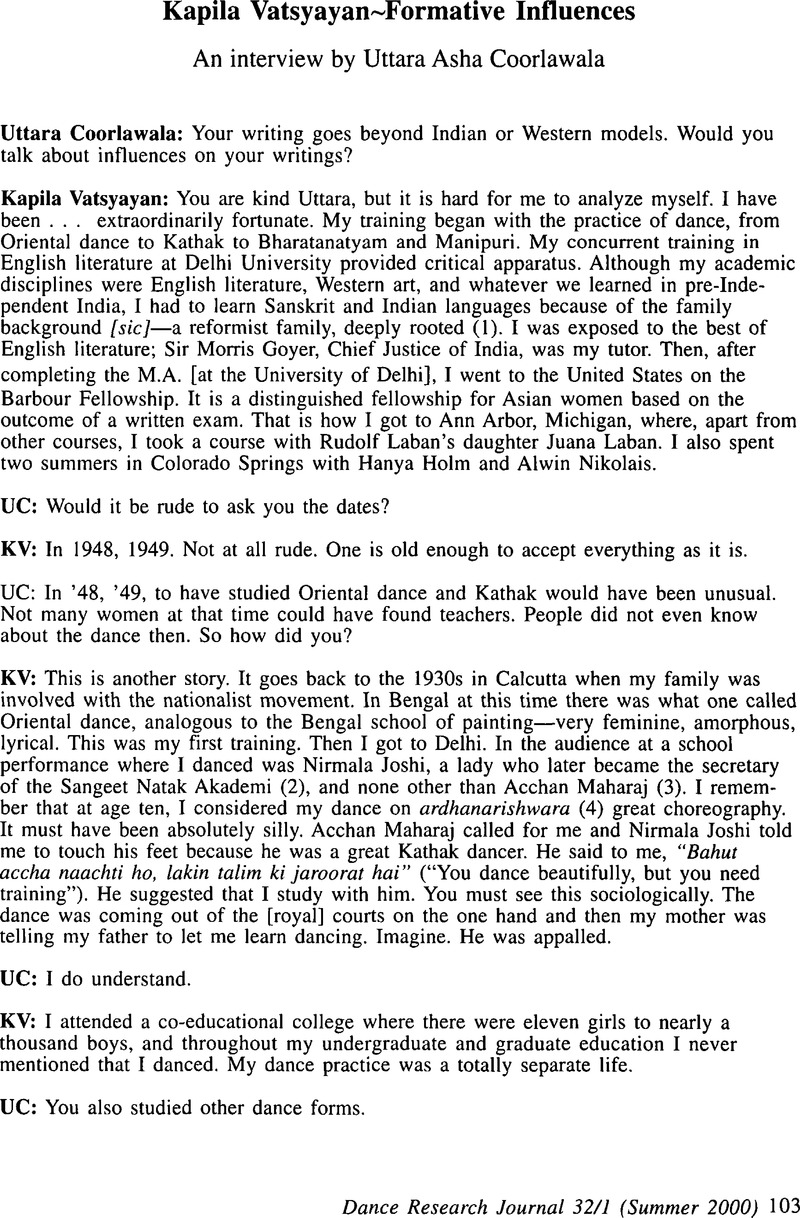Article contents
Kapila Vatsyayan~Formative Influences
Published online by Cambridge University Press: 22 July 2014
Abstract

- Type
- Kapila Vatsyayan∼Honorary Papers
- Information
- Copyright
- Copyright © Congress on Research in Dance 2000
References
Notes
1. Though we think of English as a common language across continents, it is, in fact, spoken differently in different places—in America, in Britain, in India. Nigel B. Hankin's recent book Hanklyn-Janklyn, like its earlier predecessor Hobson-Jobson by Colonel Yule, deals entirely and exclusively with a vocabulary of English words of Indian origin. Indian usages of English have been deliberately cultivated by recent Indian authors writing in English, such as Rushdie, Salman. See Hanklyn-Janklyn (New Delhi: Banyan Books, 1992).Google Scholar
2 In 1953 the Sangeet Natak Akademi was set up and funded by the Government of India as an autonomous institution to promote performance, research, and creativity in sangeet, or dance and music, and nataka (drama). Akademi resulted from an attempt to frame a non-British version of a word for arts institution as in the European sense of the word academy.
3. Aechan Maharaj (1883-1947) was a legendary performer and teacher of the Lucknow gharana (tradition, lineage) of Kathak dance. Born Jagannath Prasad, Achhan Maharaj danced in the court of Nawab Hamid Ali of Rampur before he was invited to Delhi in 1936 by Ninnala Joshi to teach at the Delhi School of Hindusthani Music and Dance where Kapila Malik (now Vatsyayan) was among his first students. See Kothari, Sunil, Kathak (New Delhi: Abhinav Publications, 1989).Google Scholar
4. Ardhanarishwara is a manifestation of Shiva whose right half is male and the left half of his body is occupied by the female form of his wife Parvati.
5. Birju Maharaj is India's leading exponent of the Lucknow lineage of Kathak dance and the son of Aechan Maharaj. Maharaj is not a last name. Rather it indicates status in the world of dancers—as a great dancer, or as a maharaja among dancers.
6. Kamaladevi Chhattopadhyaya (1903-1988) is the subject of a biography by Ka-mala Narasimhan. A political activist from a young age, Kamaladevi was immersed in the freedom struggle before Independence (1947). Involved with theater, she founded the Natya Sangh (in Bombay), and the Indian National Theatre (also in Bombay). Both organizations are still active. A widow at age nine, it was after her second marriage to the unconventional poet Harendranath Chhatopadhyaya that she went to college and was encouraged to express her independence. She is known internationally for having founded the Indian Handicrafts Board. Kapila Vatsyayan's mother, Satyavati Malik, was active in the struggle for freedom alongside Kamaladevi Chhattopadhyaya.
7. Indian philosophical and perceptual concepts of body and self are extensive, detailed, and different from Euro-American ones. “Myself as a body” indicates that Vatsyayan does not acknowledge the subject-object split which is embedded in the English-language usage of “my body,” where the body is objectified. “Myself as my culture” indicates that she questioned her relationship to her culture and to herself as an embodiment of her culture.
8. Kerala Kalamandalam is the name of an institution in Kerala (the west coast of South India) where Kathakali (a dance-drama form performed traditionally by males) is taught. Kathakali was one of the earliest “classical” dance forms to be recovered by the poet Vallathol and Manakkulam Mukunda Raja (a literary person and friend of Vallathol) who jointly established Kerala Kalamandalam in 1930.
9. The rock-carved temple at Khajuraho (ca. A.D. 1000 ) is famous for its erotic sculptures. Here, in an environment that is intended for reflection on Divinity, the visitor confronts a profusion of carvings of couples (mithuna) involved in all stages of the love act. The sculptures are not merely sexually titillating; they evoke profound emotional resonances and glorify the pleasure of both females and males in love and in sexual intercourse. Sensuality and sex are represented as yoga, a path to realization. Again, this psycho-physical perception is mirrored in danced representations of the nayika (female protagonist) as devotee and her Beloved.
10. The Indian Council for Cultural Relations is a branch of the Ministry of External Affairs that deals with projecting India's culture abroad, as for instance the several Festivals of India held in many countries. The ICCR is also the main sponsor within India of state-subsidized performing troupes from abroad.
11. Narayan Menon, an international authority on Asian traditional music and dance, was Director of the National Centre for Performing Arts in Bombay (1968-82) until he retired and served as Chairman of the Sangeet Natak Akademi in New Delhi (1982-1987). His recommendation of Balasaraswati to the Edinburgh Festival occurred early in his career while he headed All India Radio.
12. “Wah, wah” is an Indian expression of approval, such as “Bravo.”
13. I believe that the larger crisis she refers to, and which we spoke about before the interview, is what I consider the “millennium crisis” experienced by those who at the time of Independence were young and idealistic about India's great culture and free and great future. Once beautiful cities (including Delhi) are now hopelessly overcrowded, polluted ecologically, and visually raped by unplanned cheap and dirty construction. Deteriorated standards of arts are increasingly being globalized. The crisis for those senior-educated activists who knew another, gentler India, is a crisis of shattered hopes— a death of nationalism. This interview took place amid several phone calls to various government officials, including one protesting a television program aired the same morning. Kapila was contemplating resigning from her position as Academic Director of the Indira Gandhi National Centre for Arts (IGNCA) to protest government interference in autonomous institutions of culture.
- 1
- Cited by




